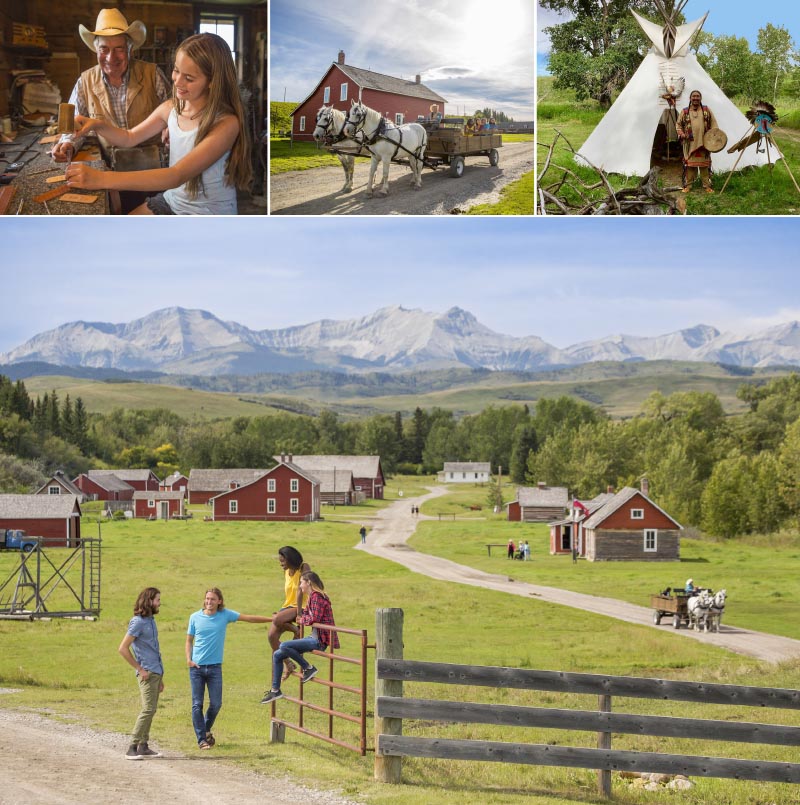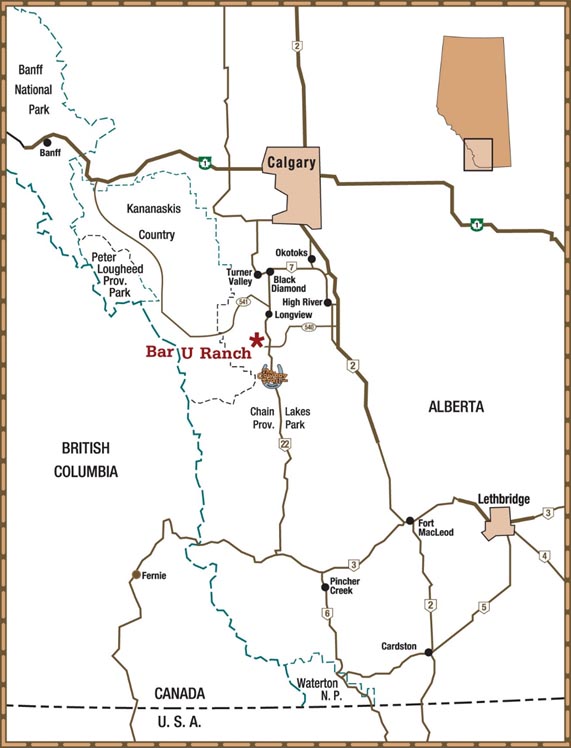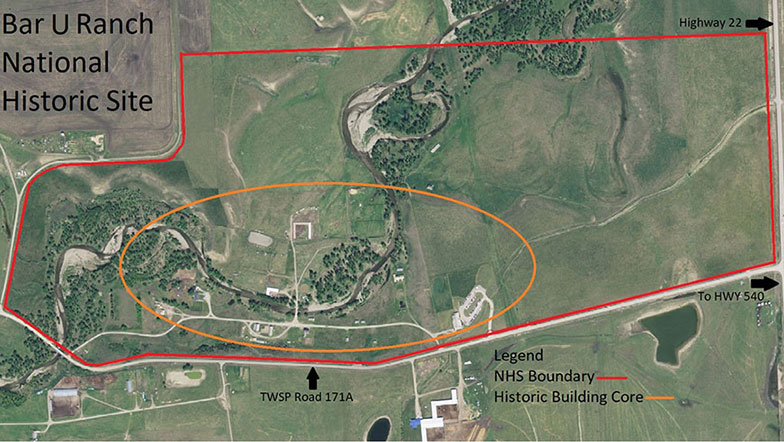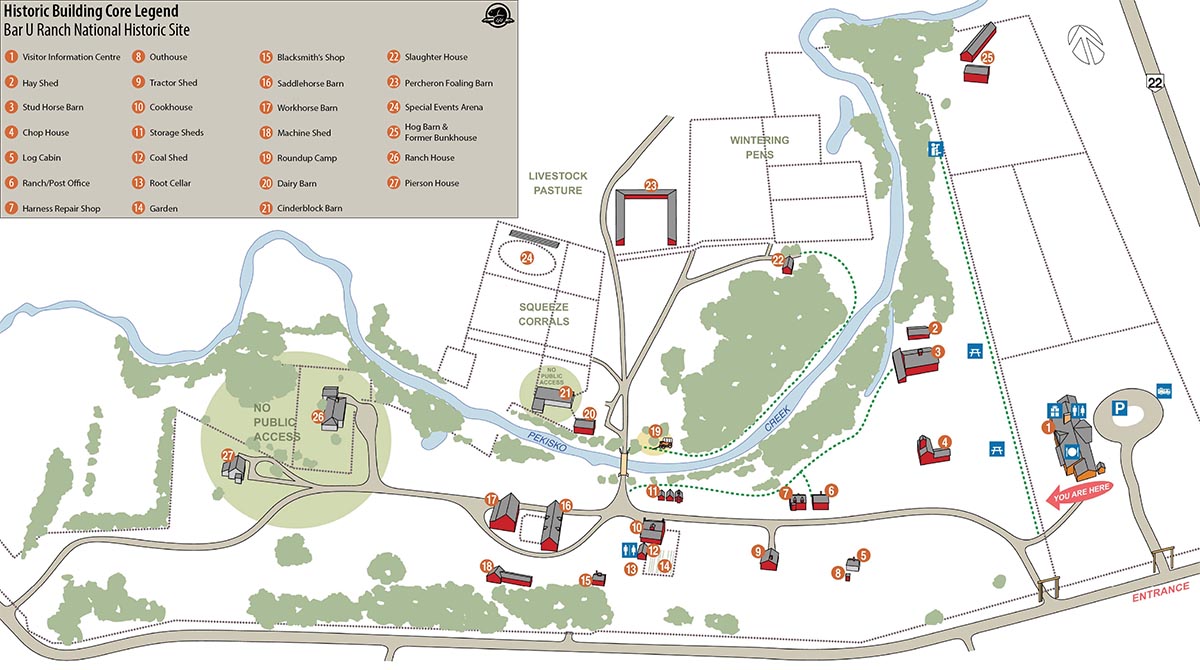Bar U Ranch National Historic Site of Canada Management Plan, 2021
Bar U Ranch National Historic Site

Note to readers
The health and safety of visitors, employees and all Canadians are of the utmost importance. Parks Canada is following the advice and guidance of public health experts to limit the spread of COVID-19 while allowing Canadians to experience Canada’s natural and cultural heritage.
Parks Canada acknowledges that the COVID-19 pandemic may have unforeseeable impacts on the Bar U Ranch National Historic Site of Canada Management Plan. Parks Canada will inform Indigenous peoples, partners, stakeholders and the public of any such impacts through its annual implementation update on the implementation of this plan.
Table of contents
Maps
Title: Bar U Ranch National Historic Site of Canada Management Plan, 2021
Organization: Parks Canada Agency
Foreword

President & Chief Executive Officer
Parks Canada
As the steward of national historic sites, national parks and national marine conservation areas in Canada, Parks Canada is committed to protecting and restoring the ecological and commemorative integrity of protected heritage areas from coast to coast to coast.
We are committed to work with, learn from, and share leadership with Indigenous peoples and elders who have walked the land since time immemorial and who have made possible the creation of so many protected places.
We acknowledge and appreciate the key role that neighbouring communities play in helping Parks Canada to fulfill its mandate, on behalf of Canadians, including many collaborations aimed at protecting ecological integrity and the provision of natural and cultural tourism related services for visitors to Bar U Ranch National Historic Site of Canada.
We are proud to collaborate with Indigenous partners, local and regional residents and stakeholders, visitors past and present, and with interested people and parties from across the country.
Together, we strive to ensure heritage places in Canada are welcoming and include diverse voices and perspectives. We invite all Canadians to these sites to discover nature and connect with the rich and varied history in Canada.
As the key accountability documents for the management of heritage places, management plans are developed through extensive consultation. These plans articulate long-term visions, set strategic management directions and establish objectives for Parks Canada administered places.
I would like to thank everyone involved in the development of this management plan for their contributions and their commitment to the future of this special place. I am pleased to present the Bar U Ranch National Historic Site of Canada Management Plan.
Recommendations
Recommended by:
Andrew Campbell
Senior Vice-President
Operations Directorate
Parks Canada Agency
Salman Rasheed
Superintendent
Waterton Lakes Field Unit
Parks Canada Agency
Executive summary
The Bar U Ranch National Historic Site (NHS) is located along Cowboy Trail (Highway 22, approximately 100 kilometres southwest of Calgary) in the heart of Alberta’s Foothills County, and is part of the Waterton Lakes Field Unit.
Established in 1882 by eastern Canadian entrepreneurs and investors, the Bar U Ranch became one of a small group of very large corporate ranches in western Canada. At its height, the Bar U Ranch spanned nearly seven townships of deeded and leased land, totalling 63,184 hectares (157,960 acres). The Bar U Ranch was designated a national historic site of Canada in 1989 in recognition of its important role in the ranching industry in Canada. Today, visitors experience the sites, sounds and smells of a living ranch through a set of interpretive nodes where interpretive talks, demonstrations and activities take place.
Three strategies are proposed to guide management activities for the Bar U Ranch NHS over the next 10 years.
Key strategy 1
Protection and maintenance of cultural and natural resources
This strategy focuses on the conservation and ongoing improvement of the Bar U Ranch NHS cultural and natural resources for the benefit of current and future generations.
The strategy aims to:
- Improve the condition of built assets through strategic investment.
- Increase knowledge and condition of cultural resources and archival records.
- Build resiliency in response to emergency situations.
- Better understand the site’s natural resources.
Key strategy 2
Enrich visitor experiences
This strategy focuses on innovative and meaningful visitor experiences, and increasing awareness of the Bar U Ranch NHS and ranching history across Canada.
The strategy aims to:
- Increase awareness and understanding of the Bar U Ranch NHS.
- Improve quality and diversity of visitor experiences.
- Connect more visitors to the natural elements of the Bar U Ranch NHS.
Key strategy 3
Collaborating to protect, present and promote the Bar U Ranch NHS
This strategy focuses on the important partnerships and key relationships that enhance experiences offered at the site and in the region.
The strategy aims to:
- Enhance existing partnerships.
- Build relationships with Indigenous groups with traditional ties to the area.
- Increase new partnerships.
Introduction
Parks Canada administers one of the finest and most extensive systems of protected natural and historic places in the world. The Agency’s mandate is to protect and present these places for the benefit and enjoyment of current and future generations. Future-oriented, strategic management of each national park, national marine conservation area, heritage canal and those national historic sites administered by Parks Canada supports the Agency’s vision:
Canada’s treasured natural and historic places will be a living legacy, connecting hearts and minds to a stronger, deeper understanding of the very essence of Canada.
The Parks Canada Agency Act requires Parks Canada to prepare a management plan for national historic sites administered by the Agency. The Bar U Ranch National Historic Site of Canada Management Plan, once approved by the President & Chief Executive Officer of Parks Canada, ensures Parks Canada’s accountability to Canadians, outlining how historic site management will achieve measurable results in support of the Agency’s mandate.
Indigenous peoples, stakeholders, partners and the Canadian public were involved in the preparation of the management plan, helping to shape the future direction of the national historic site. The plan sets clear, strategic direction for the management and operation of Bar U Ranch National Historic Site (NHS) by articulating a vision, key strategies and objectives. Parks Canada will report annually on progress toward achieving plan objectives and will review the plan every ten years or sooner if required.
This plan is not an end in and of itself. Parks Canada will maintain an open dialogue on the implementation of the management plan, to ensure that it remains relevant and meaningful. The plan will serve as the focus for ongoing engagement on the management of the Bar U Ranch NHS in years to come.
Significance of Bar U Ranch National Historic Site
The Bar U Ranch was designated a national historic site of Canada in 1989 in recognition of its important role in the ranching industry in Canada. Parks Canada worked with the Friends of the Bar U Historic Ranch Association (Friends of the Bar U), a volunteer organization, to establish Bar U Ranch as a national historic site. Bar U Ranch NHS is the only Parks Canada heritage place that commemorates the history of ranching in Canada. The site was officially opened to the public on July 1, 1995.
Established in 1882 by eastern Canadian entrepreneurs and investors, the Bar U Ranch became one of a small group of very large corporate ranches in western Canada. At its height, the Bar U Ranch spanned nearly seven townships of deeded and leased land, totalling 63,184 hectares (157,960 acres). Indigenous peoples have used the area for thousands of years and have played a direct role in the history of the ranch since the early 1900s, providing skilled labour to many ranches in the region and enjoying personal relationships with many of the ranch families. For most of its history, its size and the knowledge and connections of its owners and managers have allowed the Bar U Ranch to establish strategic relationships within a shifting economic market, ensuring the success of the ranch. Today, the majority of former Bar U Ranch leases are still in use by neighbouring ranchers.
Significant ecosystem components surround the Bar U Ranch, including tame pastures, cultivated fields, native grassland remnants and riparian zones. Other significant natural features include
habitat for native fish and wildlife populations. The ranch’s headquarters are located at the sheltered bottom of the Pekisko Creek valley, a tributary of the Highwood River. The valley is a wide floodplain with a series of terraces. Cottonwood stands line the edge of the creek. Pekisko Creek is recognized as an important fish spawning and rearing tributary to the Highwood and Bow rivers. The riparian corridor along Pekisko Creek within the Bar U Ranch territory has been set aside to protect the cottonwoods and the aquatic habitat. Beyond the river valley, the rolling uplands have cultivated grasses, grains, hay crops and an area of largely-altered native fescue grassland. The area contributes to the habitat requirements of a variety of fish and wildlife species, including some species at risk. Aquatic and riparian habitats and native grassland remnants are the most significant natural features with respect to wildlife habitat.
Planning context
The Bar U Ranch NHS is located along Cowboy Trail (Highway 22, approximately 100 kilometres southwest of Calgary) in the heart of Alberta’s Foothills County (Maps 1 and 2), and is part of the Waterton Lakes Field Unit. Seasonal staff interpret the site to visitors from mid-May to the end of September. The site is the main attraction in the local area, with strong community support from Friends of the Bar U and volunteers.
Today, the site consists of 148.43 hectares (367 acres) of land and includes the original headquarters of the Bar U Ranch, surrounding fields and outbuildings, and a portion of the Pekisko Creek (Map 3). Thirty Classified Federal Heritage Buildings are located within the boundaries of the NHS. Resources of other heritage value include eight buildings, a small number of known pre-contact Indigenous archaeological sites and a system of corrals, fences, gates and ranching and farming equipment. Federal Infrastructure Investment has contributed to the restoration of three classified heritage buildings; the Work Horse Barn restoration is scheduled for completion in 2021.
Over the past five years, the visitation trend at the site has been increasing, with an average of 20,000 visitors per year. The current visitor offer at the Bar U Ranch NHS is multi-faceted, with personal interpretation at the site taking many forms. These include the living ranch program, which has benefited from an increased livestock presence that includes Percheron horses, saddle horses, cattle, chickens, turkeys and pigs. The site is organized as a set of interpretive nodes where talks, demonstrations and activities take place. Access to the site is either on foot or by horse-drawn wagon. A variety of special events are offered throughout the summer; Canada Day and the Ranch Rodeo are the most popular, with an average of 1,000 visitors per day. Friends of the Bar U plan and implement the Ranch Rodeo and contribute to the success of many special events. Though known for iconic buildings and characters, the rangeland and riparian zones of the Bar U Ranch NHS are important natural elements of the site. Visitors are educated and inspired through displays, exhibits and buildings, in addition to the stunning landscape and natural features that tell their own stories.
Friends of the Bar U is an essential partner and works closely with Parks Canada to conserve, protect and present ranching heritage, increase public awareness, understanding, enjoyment of and engagement with the Bar U Ranch NHS. A Memorandum of Understanding (MOU) between Parks Canada and Friends of the Bar U allows the latter to contribute to visitor experience, heritage presentation, collection management and care, and livestock management. They also operate the gift shop in the Visitor Centre and support Parks Canada through the site’s volunteer program.
The Bar U Ranch NHS acknowledges that it is located within the traditional territory of Treaty 7 Nations. Initiatives are underway to enhance recent efforts to respectfully engage with Indigenous partners. The Bar U Ranch NHS remains committed to continued engagement to ensure Indigenous histories, cultures and values are shared respectfully, and told authentically, by Indigenous peoples.
This management plan builds on the successes and lessons learned from the 1995 and 2005 management plans. Previous plans provided direction for heritage presentation, heritage protection, visitor services and facilities, outreach, environmental stewardship, public involvement and partnerships, and overall operations of the site.
The key planning considerations and critical management priorities identified for the 10-year planning period include:
- Long-term sustainability of structures: the combination of program administration, technical expertise and the volume of historic buildings – 38 in total – poses a challenge for site management. An ongoing collaboration is needed between the NHS, Indigenous Affairs and Cultural Heritage and the Federal Heritage Building Review Office (FHBRO) to ensure long-term sustainability of these structures.
- Storage and management of artifacts and objects: little distinction exists between props and artifacts/objects and how staff and visitors can interact with them. Some objects can be considered pest attractants or potentially dangerous for other reasons and may put staff, visitors and cultural resources at risk. Many objects were destroyed in the 2013 flood, a 1-in-100-year event; these objects need to be formally deaccessioned/removed from the collection database. Parks Canada objects are currently stored in the foaling barn while Friends of the Bar U Ranch artifacts/objects are stored in a separate onsite storage unit.
- Adaptation to climate change: this includes fire, wind and flooding. Pekisko Creek has flooded several times since the Bar U Ranch became a Parks Canada site. These flooding events have significantly impacted the cultural resources, natural resources, visitor experience and business continuity of the Bar U Ranch NHS.
- Indigenous relations: Opportunities to incorporate Indigenous initiatives at the site are being explored with Indigenous peoples who have traditional connections with this place. Historically, relationships have focused on the Siksika and Stoney-Nakoda from the Treaty 7 groups.
- Impacts to the landscape and viewscapes: Development projects at neighbouring properties can potentially threaten and negatively impact the views, natural landscape, biodiversity and species at risk of the Bar U Ranch NHS.
Vision
This vision reflects the desired state of Bar U Ranch NHS in 15 to 20 years.
Bar U Ranch NHS is an iconic landmark that continues to connect local, regional and national audiences to the site’s past, present and future. The site educates and inspires visitors by presenting the people, land and culture of the ranching industry in Canada. The range of visitors includes Indigenous peoples, youth and new Canadians, who actively engage with the site through new programs and updated exhibits and technology. The sights, sounds and smells of the living ranch have evolved and include more ways for the public to interact with livestock and experience ranch activities through events such as demonstrations of antique farm equipment, collaboration with artists, and spotlighting of the rich local talent in the area. Trails through riparian forest and rangeland corridors provide opportunities for visitors to experience the vibrant cultural and natural history outside of our historic core. The interpretive offer includes Indigenous history and perspectives on the area, and opportunities for Indigenous peoples to share their stories and connections to the land and site. New and revitalized partnerships with Friends of the Bar U Ranch, Indigenous communities and other community partners help to promote interest in learning about ranching. The Bar U Ranch NHS is a steward of the land, animals, historic structures and cultural resources in its care, conserving these for future generations to appreciate and enjoy.
Key strategies
Three key strategies frame the management direction for the Bar U Ranch NHS over the next ten years. The strategies and corresponding objectives and targets focus on achieving the vision for the ranch through an integrated approach to site management. Updates on how the plan is being implemented will be provided to engage Indigenous peoples, key stakeholders and the Canadian public.
Key strategy 1
Protection and maintenance of cultural and natural resources
This strategy focuses on the conservation and ongoing improvement of the Bar U Ranch NHS’s cultural and natural resources for the benefit of current and future generations. Cultural and natural resources include the ranch’s buildings, artifacts, archaeology sites, viewscapes, cottonwood riparian forest along Pekisko Creek and rangeland. It also includes historical resources such as documents, stories and intergenerational knowledge that give meaning to these spaces. Protecting the cultural and natural resources from deterioration and dangers such as extreme weather events like fire and flood is a priority, particularly given that both events will increase in frequency under continued climate change.
The conservation and maintenance of historic structures and improvement of built assets is a priority for the site. A built asset and heritage building conservation strategy needs to be developed for all structures on the site to ensure long-term sustainability of historic structures and assets. Fire management and flood mitigation plans will help with emergency preparedness and decrease the likelihood of fire or floods impacting buildings and rangeland on the site. These mitigation plans will be developed within four years of management plan approval.
The Bar U Ranch NHS would benefit from a systematic inventory of archival records, an acquisition history of objects and an overall inventory review. The Bar U Ranch NHS will be engaging with the Collections and Curatorial Centre to explore options for potential management of historical artifacts. Ongoing review of relevant historical literature and new research will ensure that the Bar U Ranch NHS is able to present a range of perspectives on the history and context of ranching in Canada. To begin this work, a historical research plan will be developed within two years. To better understand the ongoing history of the Bar U Ranch and the story of ranching, interviews with those who experienced the life of the 1950s, ’60s and ’70s will be collected.
Objective 1.1
The condition of the thirty classified structures and built assets at the Bar U Ranch NHS improves as Parks Canada strategically invests in these assets.
Targets
- Within five years, the condition of the building envelopes in the historic core are maintained in “fair” condition through routine maintenance.
- The condition of built assets at the Bar U Ranch NHS are maintained at a “fair” rating in the next State of Site Assessment.
Objective 1.2
Knowledge and condition of the cultural resources and archival records related to the Bar U Ranch NHS improves.
Targets
- By 2025, inventory of archival records and information improves from 2019 levels.
- In the next State of Site Assessment, the indicators for archaeological sites and archaeological objects under the Cultural Resources theme remain “fair”.
- Within 10 years, 75% of artifacts and objects maintain their heritage value as a result of improved storage.
Objective 1.3
Bar U Ranch NHS has increased resiliency in responding to emergency situations, including those related to increased impacts of climate change.
Targets
- By 2025, the Bar U Ranch NHS will incorporate wildfire risk reduction principles such as vegetation management into its emergency response plan.
- Within 10 years, willows and cottonwoods will be planted in strategic locations along Pekisko Creek to minimize erosion and ensure greater bank stability.
Objective 1.4
Knowledge and understanding of the site’s natural resources improves, supporting better stewardship of the ranch.
Target
- By 2025, an ecological inventory assessment of the site is completed.
Key strategy 2
Enrich visitor experiences
This strategy focuses on innovative and meaningful visitor experiences, and increasing awareness of the Bar U Ranch NHS and ranching history across Canada. Enriching and interactive visitor programs will be promoted and delivered to a range of visitors, leading to increased visitation and revenue. Increased exposure for the Bar U Ranch NHS will raise awareness of the site and its surrounding area as a tourism destination. Outreach and promotional activities will connect visitors to the site’s programs and the significance of the ranch as a national historic site. People will visit the site more frequently, stay longer and include the Bar U Ranch NHS in their travel itineraries, especially en route to other destinations in southern Alberta and southeastern British Columbia. For example, the site will explore options for overnight accommodation during the next three years, with the possibility of a working offer in the next five to ten years.
The site will continue to be a safe and animated living ranch complete with heavy horses, saddle horses, cattle and other traditional livestock. An integrated trail system and bridge will create better flow between the cultural and natural elements of the site. Archaeological specimens and historical objects related to the Bar U Ranch will be assessed, evaluated and respectfully used to enhance visitor opportunities and further contribute to the public’s appreciation and understanding of the site. Indigenous perspectives and stories of the history of the area will be included as part of the Bar U Ranch NHS visitor experience offer.
Strategic planning focused on promotion, outreach and connecting visitors to the site in creative ways will be essential to achieving the objectives set out in this strategy. This planning includes the development of visitor experience and outreach strategies and may also include interpretation research, target-market analysis and visitor-use management planning. The strategy rests on the site’s unique features, engagement with partners including Indigenous peoples, research into the desires and interests of target markets, historical and archaeological research and innovative methods of site interpretation or education. A visitor experience strategy will be developed within two years of management plan approval and implemented over the life of this plan.
Objective 2.1
Awareness and understanding of the Bar U Ranch NHS increases locally and nationally.
Targets
- By 2025, 90% of visitors to the Bar U Ranch NHS leave with a deeper appreciation of the role the ranching industry has played in the history of Canada.
- Within 10 years, virtual reach increases by 10% from 2019 levels, through social media and Parks Canada’s website.
- By 2030, media interest and publications highlighting the Bar U Ranch NHS increases by 10%.
Objective 2.2
Visitation at the Bar U Ranch NHS increases as a result of the quality and diversity of visitor experience opportunities.
Targets
- By 2025, the number of events and programs the site offers increases by 5% from 2019 levels.
- Within 10 years, repeat visitation to the Bar U Ranch NHS increases by 10% from 2019 levels.
- By 2025, 80% of visitors are overall satisfied with their visit at the Bar U Ranch NHS.
Objective 2.3
More visitors are connected to the natural elements of the Bar U Ranch NHS
Targets
- By 2025, 80% of visitors have a better understanding of the natural elements of the site.
- Within 10 years, 2% of visitors use the trail system to connect to the natural elements of the Bar U Ranch NHS.
Key strategy 3
Collaborating to protect, present and promote the Bar U Ranch NHS
This strategy focuses on the important partnerships and key relationships that enhance experiences offered at the site and in the region. To achieve this, the Bar U Ranch NHS will deepen existing relationships and develop new relationships locally and regionally. The Friends of the Bar U will continue to be a major partner at the Bar U Ranch NHS, working with Parks Canada to portray the significance of the site to Canadians.
These collaborative relationships will help increase the number and type of programs and events hosted at the site, ensuring more comprehensive and cohesive storytelling of ranching in the region. Existing and new relationships will lead to an increase in the number of volunteers at the site, offering opportunities for historic and archaeological research and enhancing visitor experiences. Attention will also be focused on collaborating with tourism organizations in southern Alberta to cross-promote the site with other tourist destinations in Southern Alberta.
Strengthening relationships with local First Nations is a priority for the Bar U Ranch NHS. Indigenous presence and connection to the site will increase through the sharing of stories and inclusion of their perspectives in the overall presentation and management of the site. The Bar U Ranch NHS will commit to exploring partnerships with local First Nations and encouraging access for Indigenous peoples with traditional connections to the site.
Agreements between the Bar U Ranch NHS and commercial businesses (including leases, rights-of-way, licences-of-occupation and others) will be reviewed and updated when their terms dictate review or renewal.
Objective 3.1
Existing partnerships are enhanced
Targets
- By 2025, at least one commercial tour operator adds Bar U Ranch NHS to its itinerary.
- By 2030, the number of volunteers with the Friends of the Bar U Ranch increases by 5% from 2019 levels.
Objective 3.2
Relationship-building with Indigenous groups who have traditional ties to the area is strengthened through agreements supporting collaborative work.
Targets
- By 2025, the number of Indigenous stories and perspectives in interpretive programs and products related to the Bar U Ranch NHS increases from the 2019 service offer.
- Within 5 years, through programs such as Open Doors, the number of Indigenous visitors to the Bar U Ranch NHS increases from 2019 levels.
- Within 10 years, 90% of visitors feel they have a better understanding of Indigenous culture and history of the area after their visit.
Objective 3.3
The number of new partnerships with the Bar U Ranch NHS increases, resulting in new ways of presenting the site and the ranching industry
Targets
- Within five years, the number of new events and programs hosted in collaboration with other organizations increases from 2019 levels.
- By 2030, the number and quality of partnering and outreach initiatives for the site increases from 2019 levels.
Summary of strategic environmental assessment
The purpose of a strategic environmental assessment is to incorporate environmental considerations into the development of public policies, plans, and program proposals to support environmentally sound decision making. In accordance with the Cabinet Directive on the Environmental Assessment of Policy, Plan and Program Proposals (2010), a strategic environmental assessment was conducted on the Bar U Ranch NHS management plan. The scope was limited to the geographic boundaries of the national historic site, and the time frame was 10 years, to coincide with the management planning cycle.
Many positive effects will occur as a result of the implementation of the plan, for example: improvements to the cultural resources that support the commemorative integrity of the site. The biggest positive effects of this plan will be the creation and enhancement of visitor experiences, resulting in an increased visitor appreciation of the role ranching has played in Canada’s history. Collective knowledge and understanding of the natural resources of the Bar U Ranch NHS will be improved through the ecological inventory of the site. The management plan will help connect Canadians with nature and improve their appreciation of sustainable food production thereby contributing to the implementation of the Federal Sustainable Development Strategy.
Strategies, objectives and targets identified in the management plan that could potentially result in negative environmental effects include undertakings to support improvements to cultural, historic and built assets. However, these effects can be minimized by adhering to the appropriate standards and guidelines, and collaborating with others within the Parks Canada Agency such as Indigenous Affairs and Cultural Heritage Directorate and the Federal Heritage Buildings Review Office. Operations at the site are required to mitigate impacts on climate according to Greening Government requirements in support of the Federal Sustainable Development Strategy. Potential effects to species at risk will be addressed through policy instruments (Species at Risk Act), project-level impact assessment and the Multi-species Action Plan for Waterton Lakes National Park of Canada and Bar U Ranch National Historic Site of Canada.
Comments from Indigenous partners, stakeholders and the public were solicited and if received, incorporated into the strategic environmental assessment and management plan as appropriate.
There are no important negative environmental effects anticipated from the implementation of the management plan. Individual projects at the site will be evaluated separately under the Impact Assessment Act, or successor legislation, as necessary.
Contact us
For more information about the management plan or about Bar U Ranch National Historic Site:
Bar U Ranch National Historic Site
P.O. Box 168
Longview, AB T0L 1H0
Canada
Email: pc.baruinfo.pc@canada.ca
Bar U Ranch National Historic Site
Fax number: 403-395-2331
Publication information
© Her Majesty the Queen in Right of Canada, represented by the President & Chief Executive Officer of Parks Canada, 2021.
Front cover image credit:
top from left to right: Parks Canada
bottom: Parks Canada
Cette publication est aussi disponible en français :
Plan directeur lieu historique national du Canada du Ranch-Bar U, 2021
- Paper: R64-317/2021E
- 978-0-660-39565-4
- PDF: R64-317/2021E-PDF
- 978-0-660-39564-7
Related links
- Date modified :


